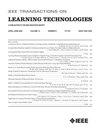课程设计中的生成式人工智能:对模型性能和教育约束的实证见解
IF 4.9
3区 教育学
Q2 COMPUTER SCIENCE, INTERDISCIPLINARY APPLICATIONS
引用次数: 0
摘要
本研究验证了大型语言模型(llm)生成课程和开发特定课程教学大纲的能力。我们提出了四个模型,为经济学和管理学学士学位生成了两套课程。我们还为课程中包含的课程制作了教学大纲。我们选择了五所提供这些学位课程的波兰公立经济大学进行比较。本实验使用了四种llm: ChatGPT-3.5、ChatGPT-4、谷歌Bard和Gemini。其中两个是多模态模型。该研究使用了迭代方法,在每次迭代中增加提示的细节。结果表明,给LLM的提示越具体,结果的准确性越低。此外,实验表明,没有一个法学硕士开发的完整课程达到与人类产生的课程相当的水平。然而,法学硕士可以极大地帮助人类创建课程和开发教学大纲,前提是人类与人工智能(AI)密切合作。人工智能辅助课程设计的结果因模型的不同而不同。通过分析工具与实际学位课程和教学大纲之间的差异,我们确定多模态模型比旧模型更适合这项任务。本文章由计算机程序翻译,如有差异,请以英文原文为准。
Generative AI in Curriculum Design: Empirical Insights Into Model Performance and Educational Constraints
This study verifies the ability of large language models (LLMs) to generate a curriculum and develop syllabi for specific courses. We prompted four models to generate two sets of curricula for a bachelor’s degree in Economics and Management. We also generated syllabi for the courses included in the curriculum. We chose five Polish public economics universities offering those degree programs for comparison. Four LLMs were used in this experiment: ChatGPT-3.5, ChatGPT-4, Google Bard, and Gemini. Two of them are multimodal models. The study used an iterative approach, increasing the detail of the prompt in each iteration. The results show that the more specific prompt is given to the LLM, the less accurate the results are. Moreover, the experiment shows that none of the LLMs developed a complete curriculum at a level comparable to that generated by humans. However, LLMs can significantly help create a curriculum and develop syllabi by humans, provided that there is close human–artificial intelligence (AI) collaboration. The results obtained from the AI-assisted curriculum design differ depending on the model. By analyzing the differences between the tools and the real degree programs and syllabi, we determined that multimodal models are better suited for this task than older models.
求助全文
通过发布文献求助,成功后即可免费获取论文全文。
去求助
来源期刊

IEEE Transactions on Learning Technologies
COMPUTER SCIENCE, INTERDISCIPLINARY APPLICATIONS-
CiteScore
7.50
自引率
5.40%
发文量
82
审稿时长
>12 weeks
期刊介绍:
The IEEE Transactions on Learning Technologies covers all advances in learning technologies and their applications, including but not limited to the following topics: innovative online learning systems; intelligent tutors; educational games; simulation systems for education and training; collaborative learning tools; learning with mobile devices; wearable devices and interfaces for learning; personalized and adaptive learning systems; tools for formative and summative assessment; tools for learning analytics and educational data mining; ontologies for learning systems; standards and web services that support learning; authoring tools for learning materials; computer support for peer tutoring; learning via computer-mediated inquiry, field, and lab work; social learning techniques; social networks and infrastructures for learning and knowledge sharing; and creation and management of learning objects.
 求助内容:
求助内容: 应助结果提醒方式:
应助结果提醒方式:


